BBMA3203 Management Accounting II: Budgeting and Standard Costing
VerifiedAdded on 2023/06/03
|13
|3240
|474
Essay
AI Summary
This essay delves into the application of budgeting and standard costing as crucial tools in management accounting for planning and performance measurement. It elucidates how budgeting facilitates the creation of financial plans, resource allocation, and performance monitoring by comparing actual results against set targets, aiding in better decision-making and control. While highlighting the advantages of budgeting, such as profitability prediction and cash allocation, it also acknowledges limitations like costliness and rigidity. The analysis extends to standard costing, a method employing standard costs to evaluate performance, control costs, and motivate employees. By comparing standard costs with actual costs, organizations can identify variances, analyze their causes, and implement corrective actions, improving overall performance and decision-making. The essay concludes that both budgeting and standard costing are indispensable for effective management accounting, enabling better planning, performance measurement, and strategic decision-making within organizations. Desklib provides solved assignments for students.
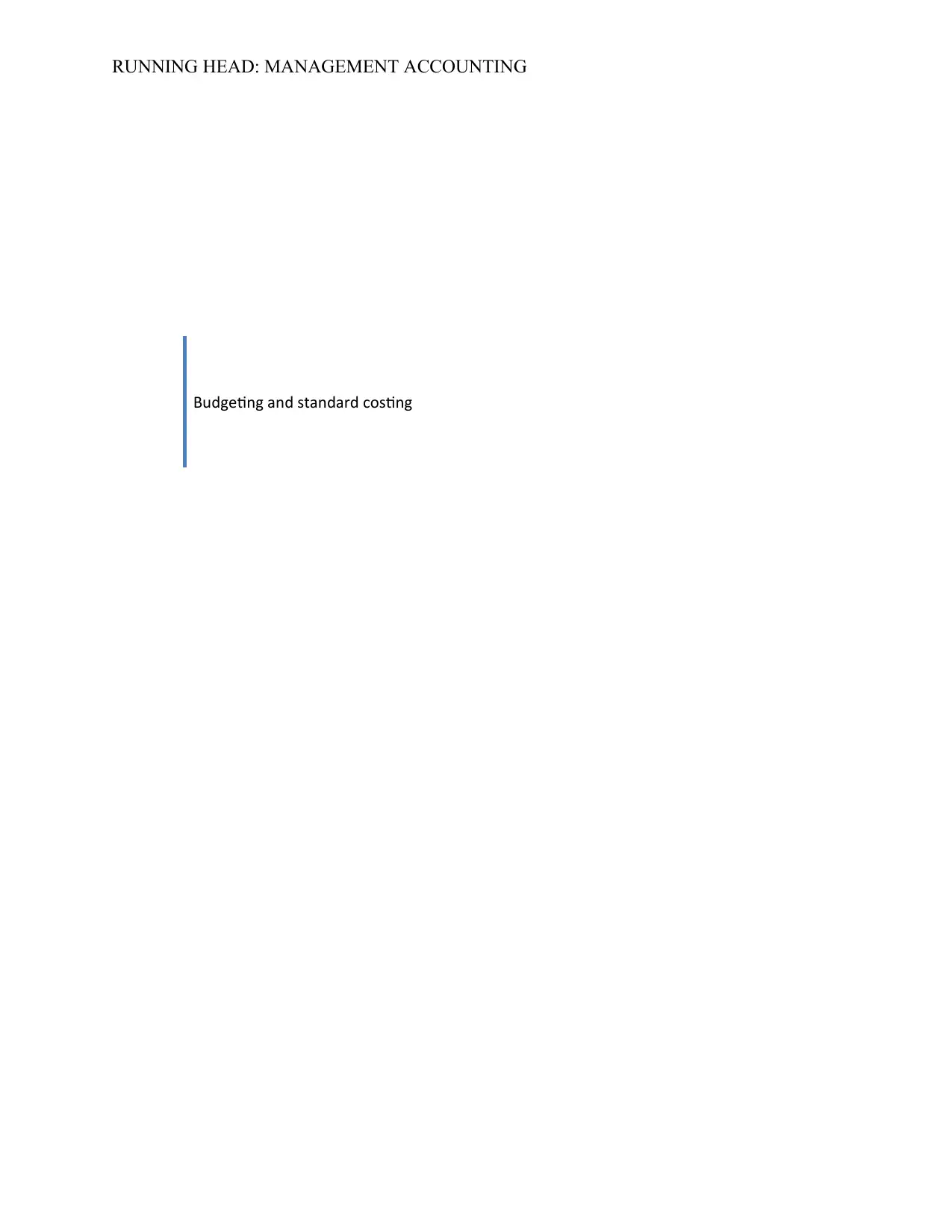
RUNNING HEAD: MANAGEMENT ACCOUNTING
Budgeting and standard costing
Budgeting and standard costing
Paraphrase This Document
Need a fresh take? Get an instant paraphrase of this document with our AI Paraphraser
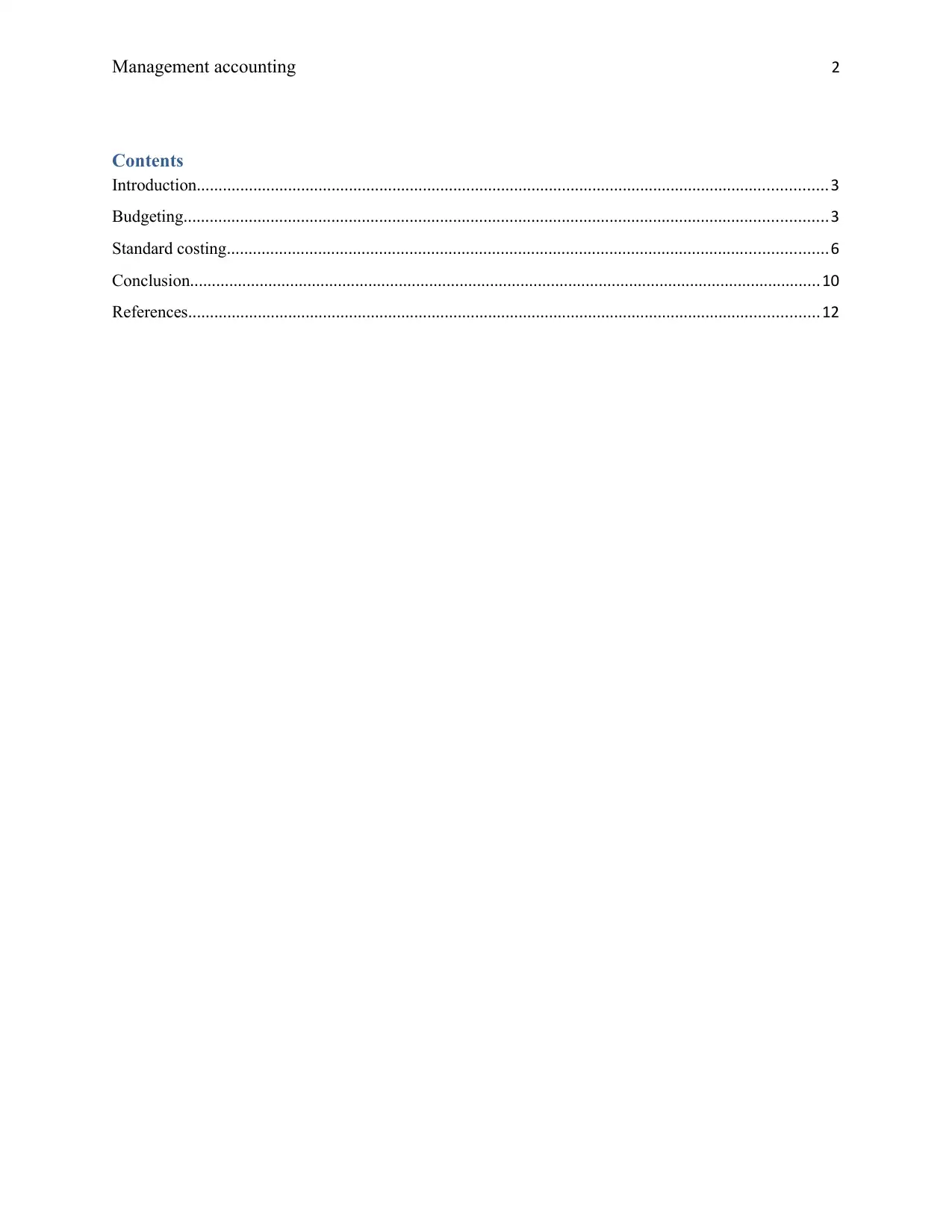
Management accounting 2
Contents
Introduction.................................................................................................................................................3
Budgeting....................................................................................................................................................3
Standard costing..........................................................................................................................................6
Conclusion.................................................................................................................................................10
References.................................................................................................................................................12
Contents
Introduction.................................................................................................................................................3
Budgeting....................................................................................................................................................3
Standard costing..........................................................................................................................................6
Conclusion.................................................................................................................................................10
References.................................................................................................................................................12
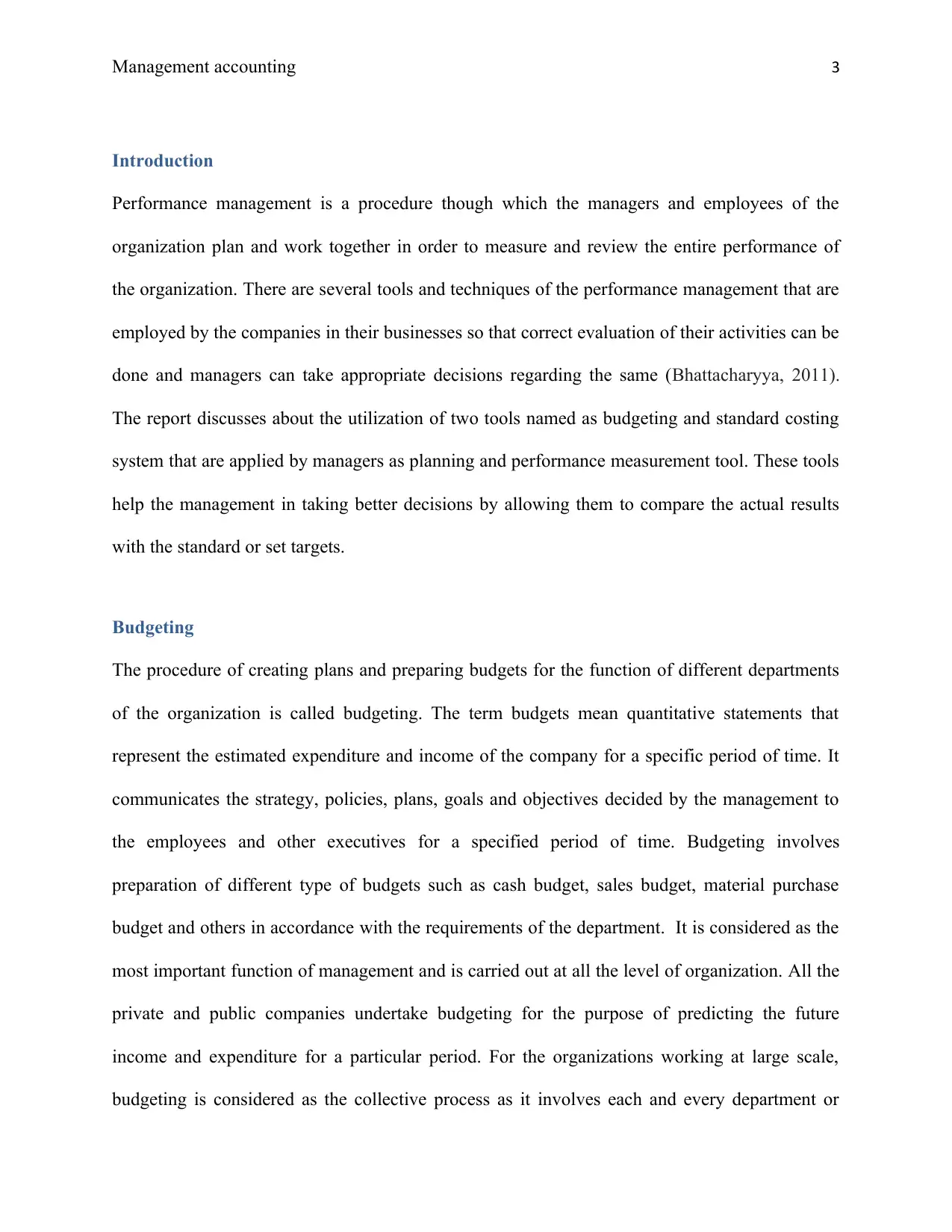
Management accounting 3
Introduction
Performance management is a procedure though which the managers and employees of the
organization plan and work together in order to measure and review the entire performance of
the organization. There are several tools and techniques of the performance management that are
employed by the companies in their businesses so that correct evaluation of their activities can be
done and managers can take appropriate decisions regarding the same (Bhattacharyya, 2011).
The report discusses about the utilization of two tools named as budgeting and standard costing
system that are applied by managers as planning and performance measurement tool. These tools
help the management in taking better decisions by allowing them to compare the actual results
with the standard or set targets.
Budgeting
The procedure of creating plans and preparing budgets for the function of different departments
of the organization is called budgeting. The term budgets mean quantitative statements that
represent the estimated expenditure and income of the company for a specific period of time. It
communicates the strategy, policies, plans, goals and objectives decided by the management to
the employees and other executives for a specified period of time. Budgeting involves
preparation of different type of budgets such as cash budget, sales budget, material purchase
budget and others in accordance with the requirements of the department. It is considered as the
most important function of management and is carried out at all the level of organization. All the
private and public companies undertake budgeting for the purpose of predicting the future
income and expenditure for a particular period. For the organizations working at large scale,
budgeting is considered as the collective process as it involves each and every department or
Introduction
Performance management is a procedure though which the managers and employees of the
organization plan and work together in order to measure and review the entire performance of
the organization. There are several tools and techniques of the performance management that are
employed by the companies in their businesses so that correct evaluation of their activities can be
done and managers can take appropriate decisions regarding the same (Bhattacharyya, 2011).
The report discusses about the utilization of two tools named as budgeting and standard costing
system that are applied by managers as planning and performance measurement tool. These tools
help the management in taking better decisions by allowing them to compare the actual results
with the standard or set targets.
Budgeting
The procedure of creating plans and preparing budgets for the function of different departments
of the organization is called budgeting. The term budgets mean quantitative statements that
represent the estimated expenditure and income of the company for a specific period of time. It
communicates the strategy, policies, plans, goals and objectives decided by the management to
the employees and other executives for a specified period of time. Budgeting involves
preparation of different type of budgets such as cash budget, sales budget, material purchase
budget and others in accordance with the requirements of the department. It is considered as the
most important function of management and is carried out at all the level of organization. All the
private and public companies undertake budgeting for the purpose of predicting the future
income and expenditure for a particular period. For the organizations working at large scale,
budgeting is considered as the collective process as it involves each and every department or
⊘ This is a preview!⊘
Do you want full access?
Subscribe today to unlock all pages.

Trusted by 1+ million students worldwide
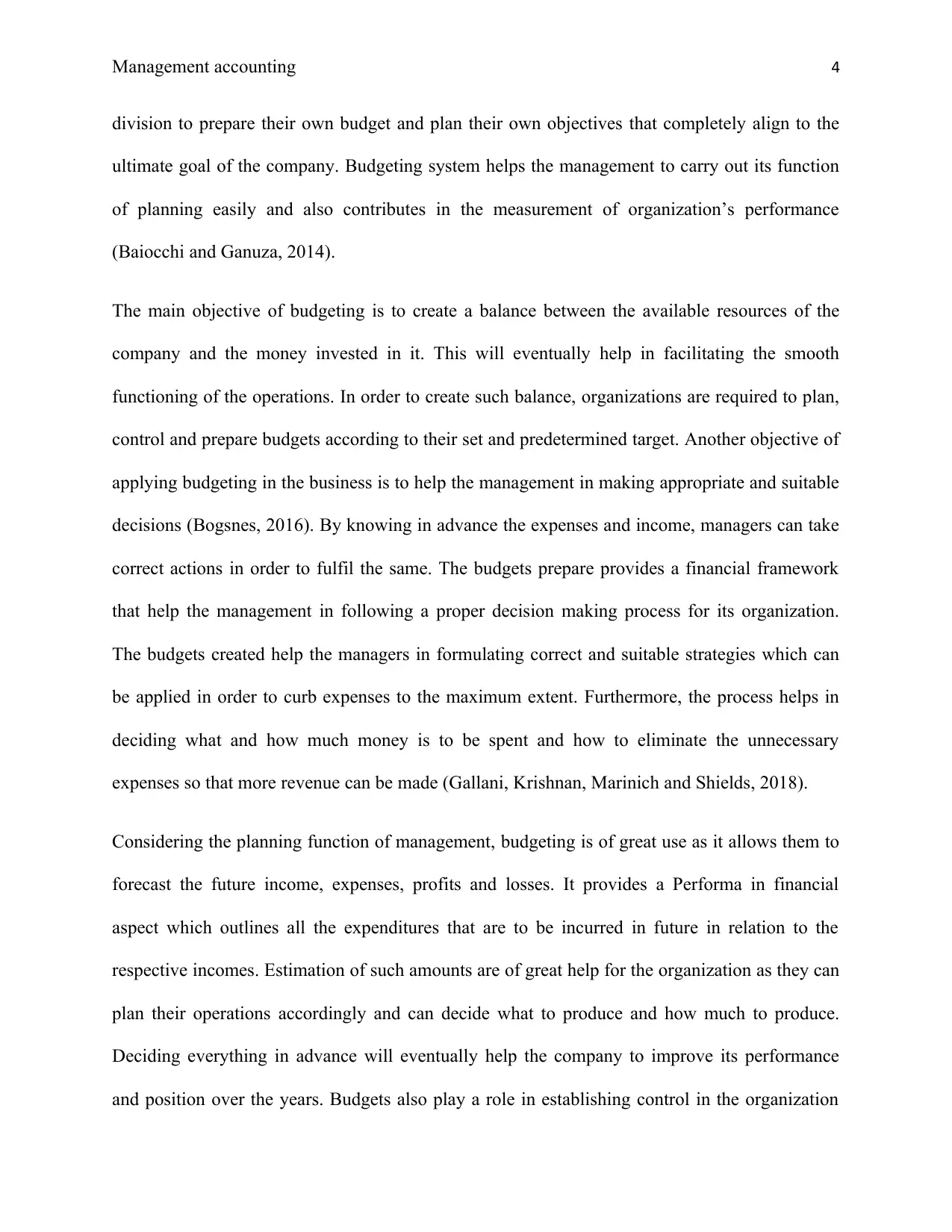
Management accounting 4
division to prepare their own budget and plan their own objectives that completely align to the
ultimate goal of the company. Budgeting system helps the management to carry out its function
of planning easily and also contributes in the measurement of organization’s performance
(Baiocchi and Ganuza, 2014).
The main objective of budgeting is to create a balance between the available resources of the
company and the money invested in it. This will eventually help in facilitating the smooth
functioning of the operations. In order to create such balance, organizations are required to plan,
control and prepare budgets according to their set and predetermined target. Another objective of
applying budgeting in the business is to help the management in making appropriate and suitable
decisions (Bogsnes, 2016). By knowing in advance the expenses and income, managers can take
correct actions in order to fulfil the same. The budgets prepare provides a financial framework
that help the management in following a proper decision making process for its organization.
The budgets created help the managers in formulating correct and suitable strategies which can
be applied in order to curb expenses to the maximum extent. Furthermore, the process helps in
deciding what and how much money is to be spent and how to eliminate the unnecessary
expenses so that more revenue can be made (Gallani, Krishnan, Marinich and Shields, 2018).
Considering the planning function of management, budgeting is of great use as it allows them to
forecast the future income, expenses, profits and losses. It provides a Performa in financial
aspect which outlines all the expenditures that are to be incurred in future in relation to the
respective incomes. Estimation of such amounts are of great help for the organization as they can
plan their operations accordingly and can decide what to produce and how much to produce.
Deciding everything in advance will eventually help the company to improve its performance
and position over the years. Budgets also play a role in establishing control in the organization
division to prepare their own budget and plan their own objectives that completely align to the
ultimate goal of the company. Budgeting system helps the management to carry out its function
of planning easily and also contributes in the measurement of organization’s performance
(Baiocchi and Ganuza, 2014).
The main objective of budgeting is to create a balance between the available resources of the
company and the money invested in it. This will eventually help in facilitating the smooth
functioning of the operations. In order to create such balance, organizations are required to plan,
control and prepare budgets according to their set and predetermined target. Another objective of
applying budgeting in the business is to help the management in making appropriate and suitable
decisions (Bogsnes, 2016). By knowing in advance the expenses and income, managers can take
correct actions in order to fulfil the same. The budgets prepare provides a financial framework
that help the management in following a proper decision making process for its organization.
The budgets created help the managers in formulating correct and suitable strategies which can
be applied in order to curb expenses to the maximum extent. Furthermore, the process helps in
deciding what and how much money is to be spent and how to eliminate the unnecessary
expenses so that more revenue can be made (Gallani, Krishnan, Marinich and Shields, 2018).
Considering the planning function of management, budgeting is of great use as it allows them to
forecast the future income, expenses, profits and losses. It provides a Performa in financial
aspect which outlines all the expenditures that are to be incurred in future in relation to the
respective incomes. Estimation of such amounts are of great help for the organization as they can
plan their operations accordingly and can decide what to produce and how much to produce.
Deciding everything in advance will eventually help the company to improve its performance
and position over the years. Budgets also play a role in establishing control in the organization
Paraphrase This Document
Need a fresh take? Get an instant paraphrase of this document with our AI Paraphraser
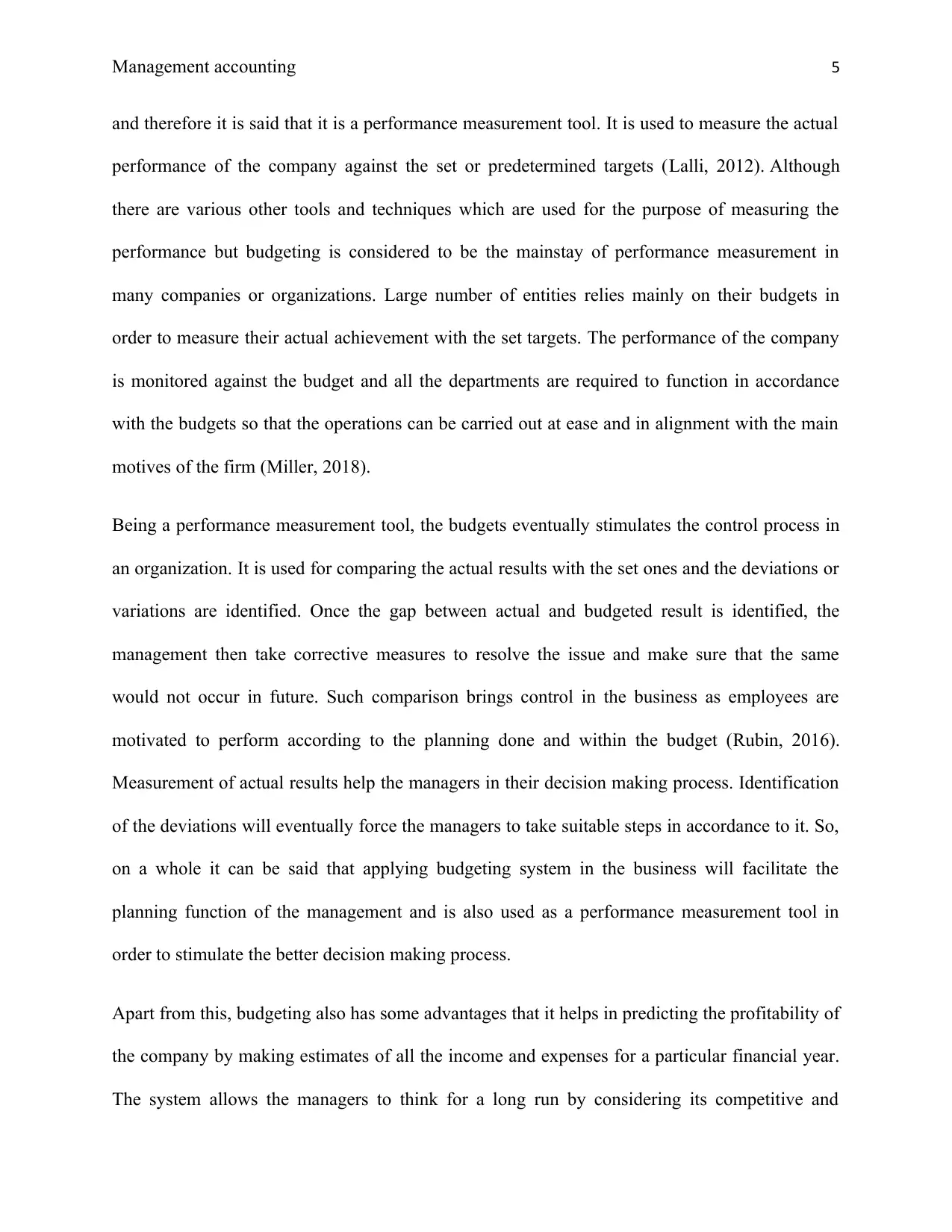
Management accounting 5
and therefore it is said that it is a performance measurement tool. It is used to measure the actual
performance of the company against the set or predetermined targets (Lalli, 2012). Although
there are various other tools and techniques which are used for the purpose of measuring the
performance but budgeting is considered to be the mainstay of performance measurement in
many companies or organizations. Large number of entities relies mainly on their budgets in
order to measure their actual achievement with the set targets. The performance of the company
is monitored against the budget and all the departments are required to function in accordance
with the budgets so that the operations can be carried out at ease and in alignment with the main
motives of the firm (Miller, 2018).
Being a performance measurement tool, the budgets eventually stimulates the control process in
an organization. It is used for comparing the actual results with the set ones and the deviations or
variations are identified. Once the gap between actual and budgeted result is identified, the
management then take corrective measures to resolve the issue and make sure that the same
would not occur in future. Such comparison brings control in the business as employees are
motivated to perform according to the planning done and within the budget (Rubin, 2016).
Measurement of actual results help the managers in their decision making process. Identification
of the deviations will eventually force the managers to take suitable steps in accordance to it. So,
on a whole it can be said that applying budgeting system in the business will facilitate the
planning function of the management and is also used as a performance measurement tool in
order to stimulate the better decision making process.
Apart from this, budgeting also has some advantages that it helps in predicting the profitability of
the company by making estimates of all the income and expenses for a particular financial year.
The system allows the managers to think for a long run by considering its competitive and
and therefore it is said that it is a performance measurement tool. It is used to measure the actual
performance of the company against the set or predetermined targets (Lalli, 2012). Although
there are various other tools and techniques which are used for the purpose of measuring the
performance but budgeting is considered to be the mainstay of performance measurement in
many companies or organizations. Large number of entities relies mainly on their budgets in
order to measure their actual achievement with the set targets. The performance of the company
is monitored against the budget and all the departments are required to function in accordance
with the budgets so that the operations can be carried out at ease and in alignment with the main
motives of the firm (Miller, 2018).
Being a performance measurement tool, the budgets eventually stimulates the control process in
an organization. It is used for comparing the actual results with the set ones and the deviations or
variations are identified. Once the gap between actual and budgeted result is identified, the
management then take corrective measures to resolve the issue and make sure that the same
would not occur in future. Such comparison brings control in the business as employees are
motivated to perform according to the planning done and within the budget (Rubin, 2016).
Measurement of actual results help the managers in their decision making process. Identification
of the deviations will eventually force the managers to take suitable steps in accordance to it. So,
on a whole it can be said that applying budgeting system in the business will facilitate the
planning function of the management and is also used as a performance measurement tool in
order to stimulate the better decision making process.
Apart from this, budgeting also has some advantages that it helps in predicting the profitability of
the company by making estimates of all the income and expenses for a particular financial year.
The system allows the managers to think for a long run by considering its competitive and
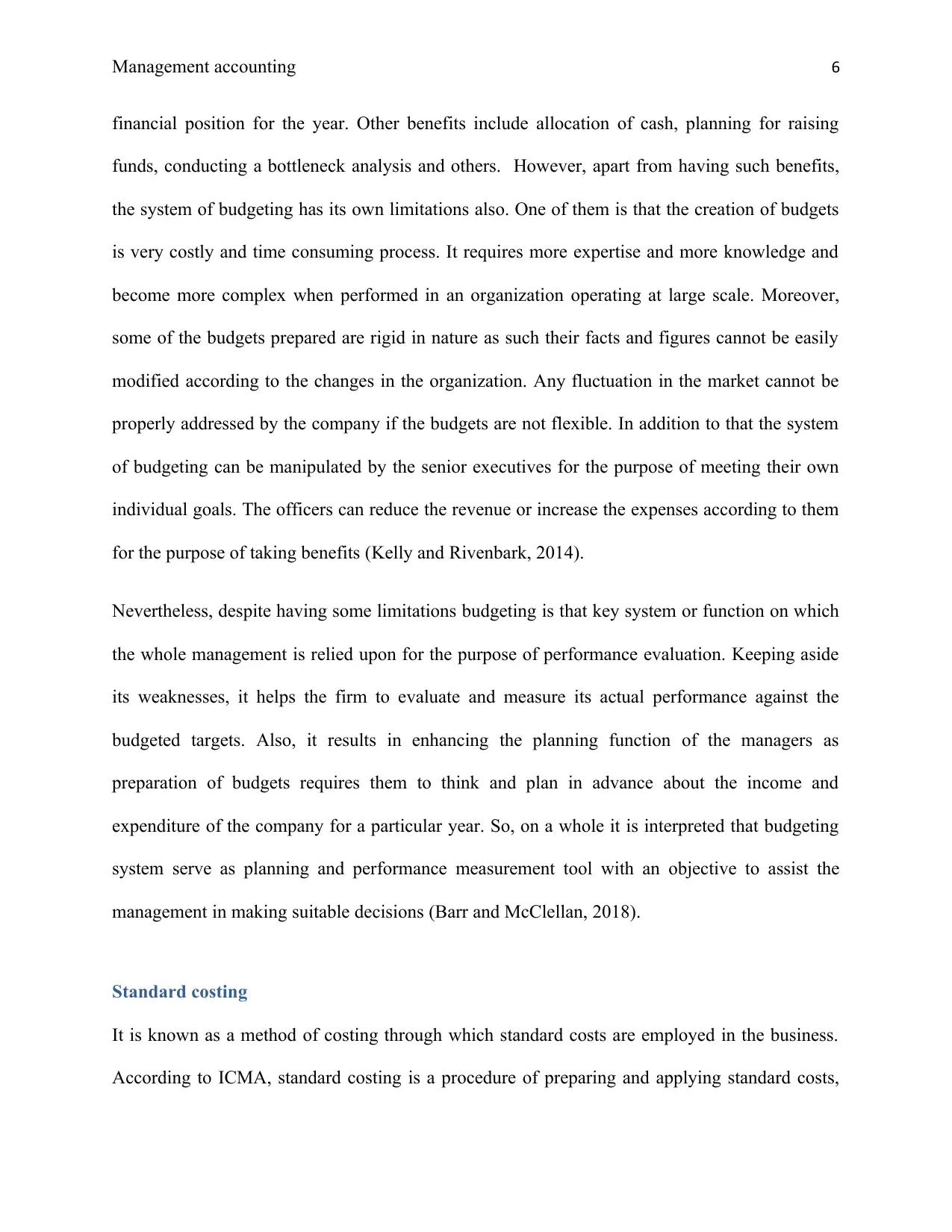
Management accounting 6
financial position for the year. Other benefits include allocation of cash, planning for raising
funds, conducting a bottleneck analysis and others. However, apart from having such benefits,
the system of budgeting has its own limitations also. One of them is that the creation of budgets
is very costly and time consuming process. It requires more expertise and more knowledge and
become more complex when performed in an organization operating at large scale. Moreover,
some of the budgets prepared are rigid in nature as such their facts and figures cannot be easily
modified according to the changes in the organization. Any fluctuation in the market cannot be
properly addressed by the company if the budgets are not flexible. In addition to that the system
of budgeting can be manipulated by the senior executives for the purpose of meeting their own
individual goals. The officers can reduce the revenue or increase the expenses according to them
for the purpose of taking benefits (Kelly and Rivenbark, 2014).
Nevertheless, despite having some limitations budgeting is that key system or function on which
the whole management is relied upon for the purpose of performance evaluation. Keeping aside
its weaknesses, it helps the firm to evaluate and measure its actual performance against the
budgeted targets. Also, it results in enhancing the planning function of the managers as
preparation of budgets requires them to think and plan in advance about the income and
expenditure of the company for a particular year. So, on a whole it is interpreted that budgeting
system serve as planning and performance measurement tool with an objective to assist the
management in making suitable decisions (Barr and McClellan, 2018).
Standard costing
It is known as a method of costing through which standard costs are employed in the business.
According to ICMA, standard costing is a procedure of preparing and applying standard costs,
financial position for the year. Other benefits include allocation of cash, planning for raising
funds, conducting a bottleneck analysis and others. However, apart from having such benefits,
the system of budgeting has its own limitations also. One of them is that the creation of budgets
is very costly and time consuming process. It requires more expertise and more knowledge and
become more complex when performed in an organization operating at large scale. Moreover,
some of the budgets prepared are rigid in nature as such their facts and figures cannot be easily
modified according to the changes in the organization. Any fluctuation in the market cannot be
properly addressed by the company if the budgets are not flexible. In addition to that the system
of budgeting can be manipulated by the senior executives for the purpose of meeting their own
individual goals. The officers can reduce the revenue or increase the expenses according to them
for the purpose of taking benefits (Kelly and Rivenbark, 2014).
Nevertheless, despite having some limitations budgeting is that key system or function on which
the whole management is relied upon for the purpose of performance evaluation. Keeping aside
its weaknesses, it helps the firm to evaluate and measure its actual performance against the
budgeted targets. Also, it results in enhancing the planning function of the managers as
preparation of budgets requires them to think and plan in advance about the income and
expenditure of the company for a particular year. So, on a whole it is interpreted that budgeting
system serve as planning and performance measurement tool with an objective to assist the
management in making suitable decisions (Barr and McClellan, 2018).
Standard costing
It is known as a method of costing through which standard costs are employed in the business.
According to ICMA, standard costing is a procedure of preparing and applying standard costs,
⊘ This is a preview!⊘
Do you want full access?
Subscribe today to unlock all pages.

Trusted by 1+ million students worldwide
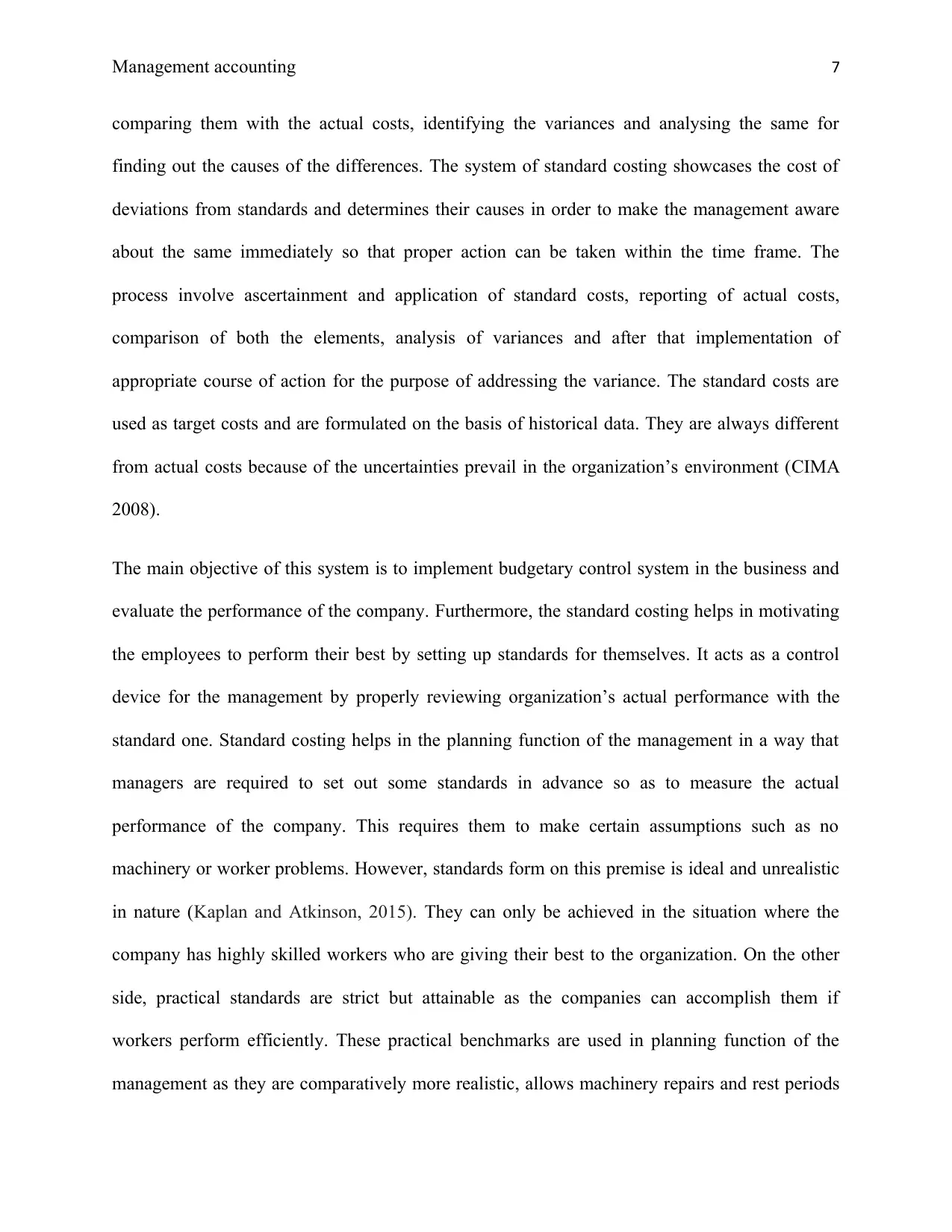
Management accounting 7
comparing them with the actual costs, identifying the variances and analysing the same for
finding out the causes of the differences. The system of standard costing showcases the cost of
deviations from standards and determines their causes in order to make the management aware
about the same immediately so that proper action can be taken within the time frame. The
process involve ascertainment and application of standard costs, reporting of actual costs,
comparison of both the elements, analysis of variances and after that implementation of
appropriate course of action for the purpose of addressing the variance. The standard costs are
used as target costs and are formulated on the basis of historical data. They are always different
from actual costs because of the uncertainties prevail in the organization’s environment (CIMA
2008).
The main objective of this system is to implement budgetary control system in the business and
evaluate the performance of the company. Furthermore, the standard costing helps in motivating
the employees to perform their best by setting up standards for themselves. It acts as a control
device for the management by properly reviewing organization’s actual performance with the
standard one. Standard costing helps in the planning function of the management in a way that
managers are required to set out some standards in advance so as to measure the actual
performance of the company. This requires them to make certain assumptions such as no
machinery or worker problems. However, standards form on this premise is ideal and unrealistic
in nature (Kaplan and Atkinson, 2015). They can only be achieved in the situation where the
company has highly skilled workers who are giving their best to the organization. On the other
side, practical standards are strict but attainable as the companies can accomplish them if
workers perform efficiently. These practical benchmarks are used in planning function of the
management as they are comparatively more realistic, allows machinery repairs and rest periods
comparing them with the actual costs, identifying the variances and analysing the same for
finding out the causes of the differences. The system of standard costing showcases the cost of
deviations from standards and determines their causes in order to make the management aware
about the same immediately so that proper action can be taken within the time frame. The
process involve ascertainment and application of standard costs, reporting of actual costs,
comparison of both the elements, analysis of variances and after that implementation of
appropriate course of action for the purpose of addressing the variance. The standard costs are
used as target costs and are formulated on the basis of historical data. They are always different
from actual costs because of the uncertainties prevail in the organization’s environment (CIMA
2008).
The main objective of this system is to implement budgetary control system in the business and
evaluate the performance of the company. Furthermore, the standard costing helps in motivating
the employees to perform their best by setting up standards for themselves. It acts as a control
device for the management by properly reviewing organization’s actual performance with the
standard one. Standard costing helps in the planning function of the management in a way that
managers are required to set out some standards in advance so as to measure the actual
performance of the company. This requires them to make certain assumptions such as no
machinery or worker problems. However, standards form on this premise is ideal and unrealistic
in nature (Kaplan and Atkinson, 2015). They can only be achieved in the situation where the
company has highly skilled workers who are giving their best to the organization. On the other
side, practical standards are strict but attainable as the companies can accomplish them if
workers perform efficiently. These practical benchmarks are used in planning function of the
management as they are comparatively more realistic, allows machinery repairs and rest periods
Paraphrase This Document
Need a fresh take? Get an instant paraphrase of this document with our AI Paraphraser
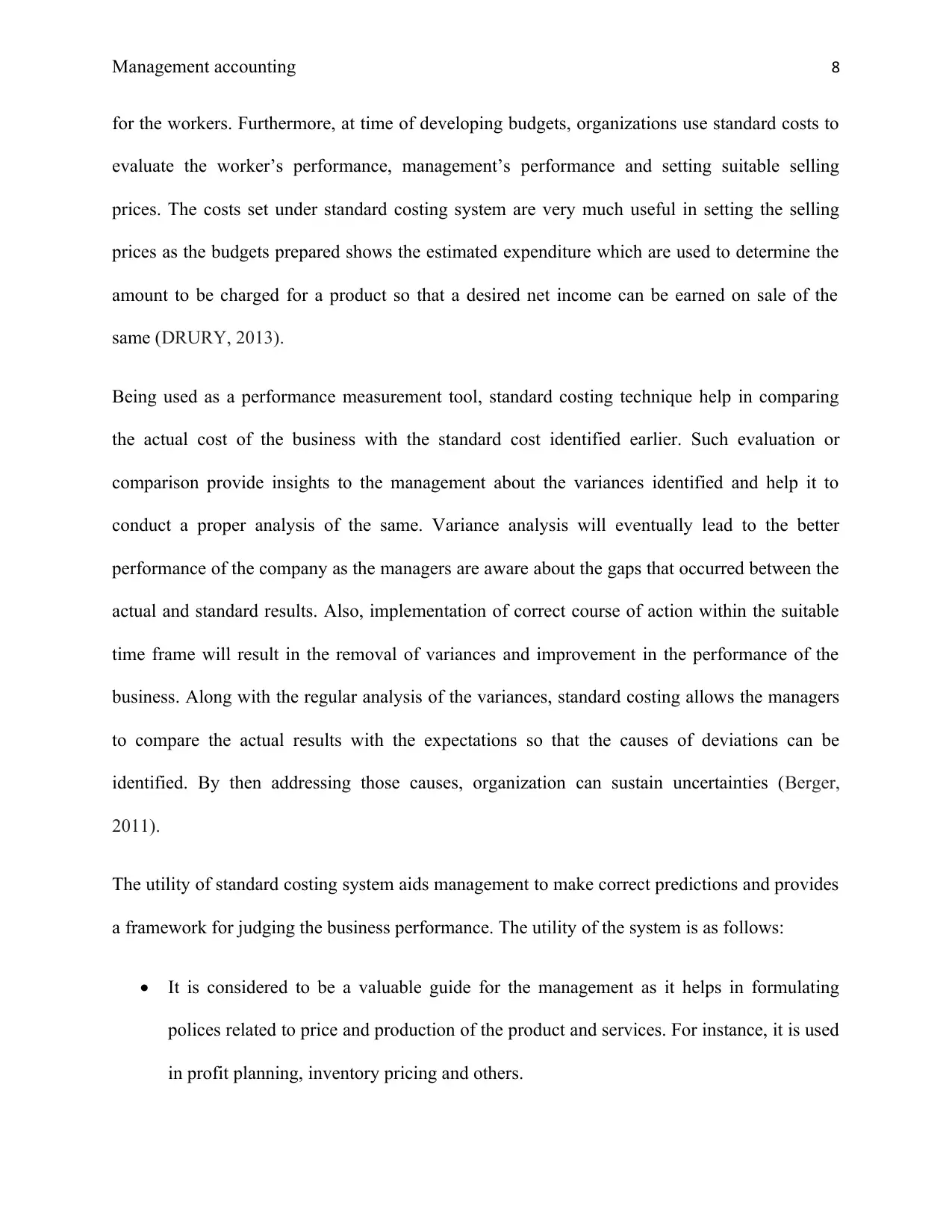
Management accounting 8
for the workers. Furthermore, at time of developing budgets, organizations use standard costs to
evaluate the worker’s performance, management’s performance and setting suitable selling
prices. The costs set under standard costing system are very much useful in setting the selling
prices as the budgets prepared shows the estimated expenditure which are used to determine the
amount to be charged for a product so that a desired net income can be earned on sale of the
same (DRURY, 2013).
Being used as a performance measurement tool, standard costing technique help in comparing
the actual cost of the business with the standard cost identified earlier. Such evaluation or
comparison provide insights to the management about the variances identified and help it to
conduct a proper analysis of the same. Variance analysis will eventually lead to the better
performance of the company as the managers are aware about the gaps that occurred between the
actual and standard results. Also, implementation of correct course of action within the suitable
time frame will result in the removal of variances and improvement in the performance of the
business. Along with the regular analysis of the variances, standard costing allows the managers
to compare the actual results with the expectations so that the causes of deviations can be
identified. By then addressing those causes, organization can sustain uncertainties (Berger,
2011).
The utility of standard costing system aids management to make correct predictions and provides
a framework for judging the business performance. The utility of the system is as follows:
It is considered to be a valuable guide for the management as it helps in formulating
polices related to price and production of the product and services. For instance, it is used
in profit planning, inventory pricing and others.
for the workers. Furthermore, at time of developing budgets, organizations use standard costs to
evaluate the worker’s performance, management’s performance and setting suitable selling
prices. The costs set under standard costing system are very much useful in setting the selling
prices as the budgets prepared shows the estimated expenditure which are used to determine the
amount to be charged for a product so that a desired net income can be earned on sale of the
same (DRURY, 2013).
Being used as a performance measurement tool, standard costing technique help in comparing
the actual cost of the business with the standard cost identified earlier. Such evaluation or
comparison provide insights to the management about the variances identified and help it to
conduct a proper analysis of the same. Variance analysis will eventually lead to the better
performance of the company as the managers are aware about the gaps that occurred between the
actual and standard results. Also, implementation of correct course of action within the suitable
time frame will result in the removal of variances and improvement in the performance of the
business. Along with the regular analysis of the variances, standard costing allows the managers
to compare the actual results with the expectations so that the causes of deviations can be
identified. By then addressing those causes, organization can sustain uncertainties (Berger,
2011).
The utility of standard costing system aids management to make correct predictions and provides
a framework for judging the business performance. The utility of the system is as follows:
It is considered to be a valuable guide for the management as it helps in formulating
polices related to price and production of the product and services. For instance, it is used
in profit planning, inventory pricing and others.
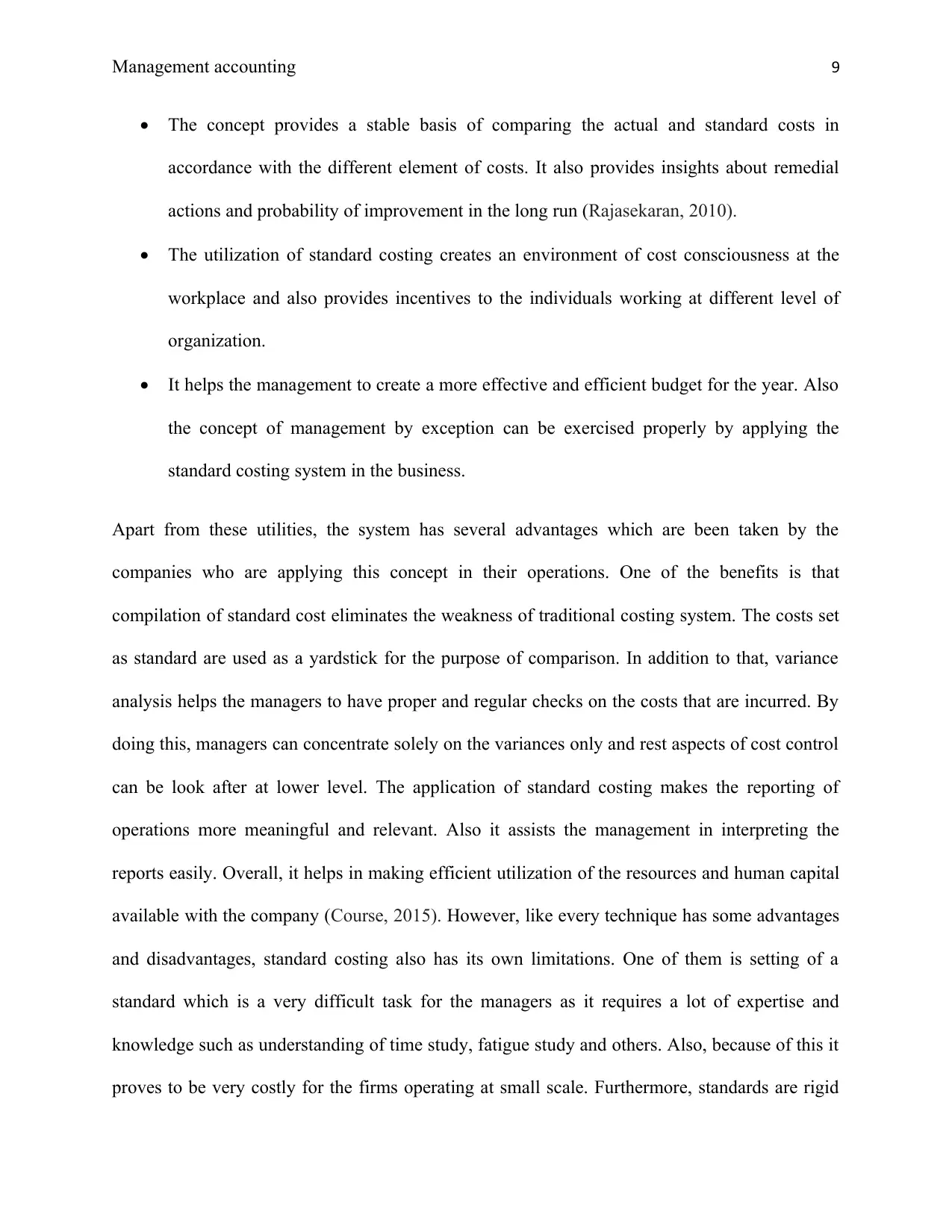
Management accounting 9
The concept provides a stable basis of comparing the actual and standard costs in
accordance with the different element of costs. It also provides insights about remedial
actions and probability of improvement in the long run (Rajasekaran, 2010).
The utilization of standard costing creates an environment of cost consciousness at the
workplace and also provides incentives to the individuals working at different level of
organization.
It helps the management to create a more effective and efficient budget for the year. Also
the concept of management by exception can be exercised properly by applying the
standard costing system in the business.
Apart from these utilities, the system has several advantages which are been taken by the
companies who are applying this concept in their operations. One of the benefits is that
compilation of standard cost eliminates the weakness of traditional costing system. The costs set
as standard are used as a yardstick for the purpose of comparison. In addition to that, variance
analysis helps the managers to have proper and regular checks on the costs that are incurred. By
doing this, managers can concentrate solely on the variances only and rest aspects of cost control
can be look after at lower level. The application of standard costing makes the reporting of
operations more meaningful and relevant. Also it assists the management in interpreting the
reports easily. Overall, it helps in making efficient utilization of the resources and human capital
available with the company (Course, 2015). However, like every technique has some advantages
and disadvantages, standard costing also has its own limitations. One of them is setting of a
standard which is a very difficult task for the managers as it requires a lot of expertise and
knowledge such as understanding of time study, fatigue study and others. Also, because of this it
proves to be very costly for the firms operating at small scale. Furthermore, standards are rigid
The concept provides a stable basis of comparing the actual and standard costs in
accordance with the different element of costs. It also provides insights about remedial
actions and probability of improvement in the long run (Rajasekaran, 2010).
The utilization of standard costing creates an environment of cost consciousness at the
workplace and also provides incentives to the individuals working at different level of
organization.
It helps the management to create a more effective and efficient budget for the year. Also
the concept of management by exception can be exercised properly by applying the
standard costing system in the business.
Apart from these utilities, the system has several advantages which are been taken by the
companies who are applying this concept in their operations. One of the benefits is that
compilation of standard cost eliminates the weakness of traditional costing system. The costs set
as standard are used as a yardstick for the purpose of comparison. In addition to that, variance
analysis helps the managers to have proper and regular checks on the costs that are incurred. By
doing this, managers can concentrate solely on the variances only and rest aspects of cost control
can be look after at lower level. The application of standard costing makes the reporting of
operations more meaningful and relevant. Also it assists the management in interpreting the
reports easily. Overall, it helps in making efficient utilization of the resources and human capital
available with the company (Course, 2015). However, like every technique has some advantages
and disadvantages, standard costing also has its own limitations. One of them is setting of a
standard which is a very difficult task for the managers as it requires a lot of expertise and
knowledge such as understanding of time study, fatigue study and others. Also, because of this it
proves to be very costly for the firms operating at small scale. Furthermore, standards are rigid
⊘ This is a preview!⊘
Do you want full access?
Subscribe today to unlock all pages.

Trusted by 1+ million students worldwide
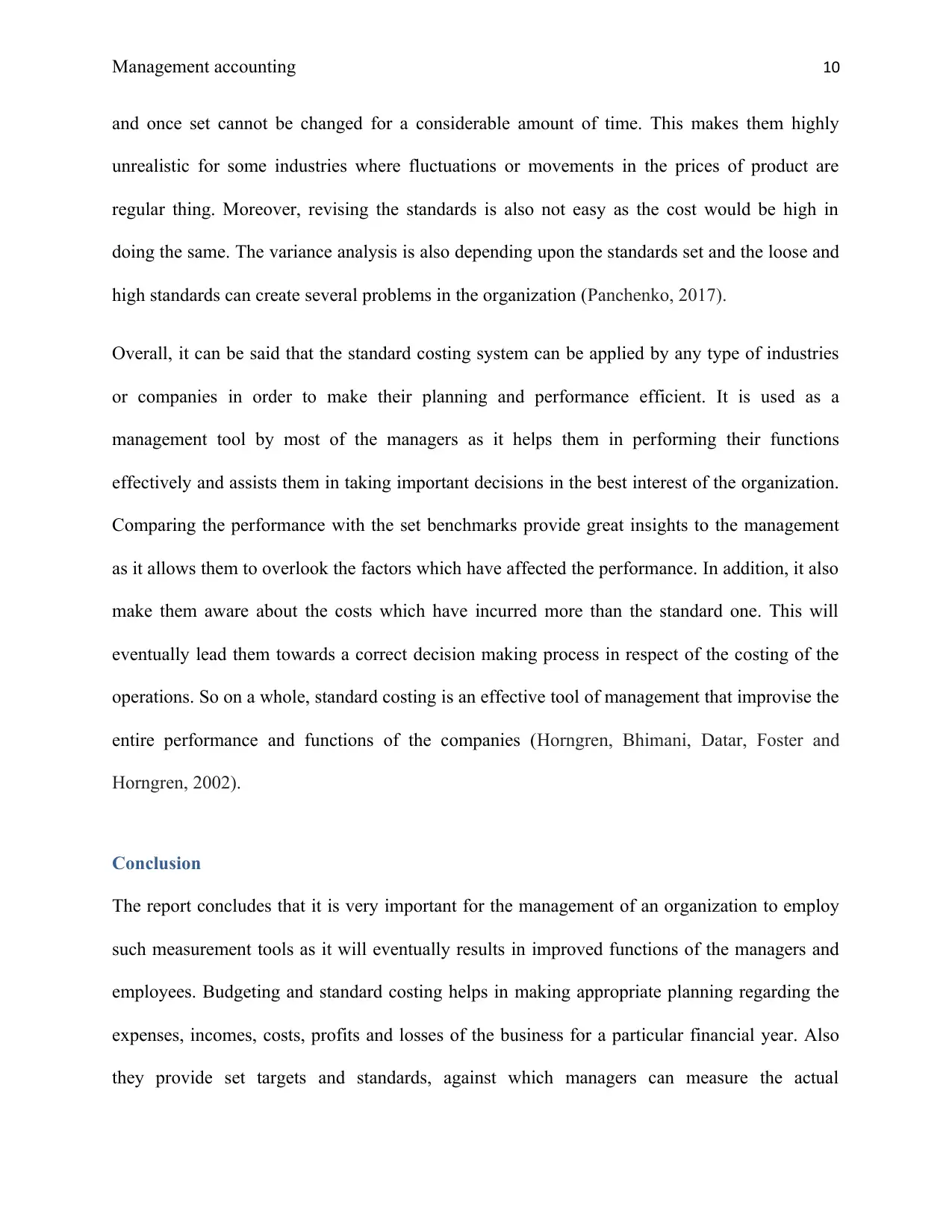
Management accounting 10
and once set cannot be changed for a considerable amount of time. This makes them highly
unrealistic for some industries where fluctuations or movements in the prices of product are
regular thing. Moreover, revising the standards is also not easy as the cost would be high in
doing the same. The variance analysis is also depending upon the standards set and the loose and
high standards can create several problems in the organization (Panchenko, 2017).
Overall, it can be said that the standard costing system can be applied by any type of industries
or companies in order to make their planning and performance efficient. It is used as a
management tool by most of the managers as it helps them in performing their functions
effectively and assists them in taking important decisions in the best interest of the organization.
Comparing the performance with the set benchmarks provide great insights to the management
as it allows them to overlook the factors which have affected the performance. In addition, it also
make them aware about the costs which have incurred more than the standard one. This will
eventually lead them towards a correct decision making process in respect of the costing of the
operations. So on a whole, standard costing is an effective tool of management that improvise the
entire performance and functions of the companies (Horngren, Bhimani, Datar, Foster and
Horngren, 2002).
Conclusion
The report concludes that it is very important for the management of an organization to employ
such measurement tools as it will eventually results in improved functions of the managers and
employees. Budgeting and standard costing helps in making appropriate planning regarding the
expenses, incomes, costs, profits and losses of the business for a particular financial year. Also
they provide set targets and standards, against which managers can measure the actual
and once set cannot be changed for a considerable amount of time. This makes them highly
unrealistic for some industries where fluctuations or movements in the prices of product are
regular thing. Moreover, revising the standards is also not easy as the cost would be high in
doing the same. The variance analysis is also depending upon the standards set and the loose and
high standards can create several problems in the organization (Panchenko, 2017).
Overall, it can be said that the standard costing system can be applied by any type of industries
or companies in order to make their planning and performance efficient. It is used as a
management tool by most of the managers as it helps them in performing their functions
effectively and assists them in taking important decisions in the best interest of the organization.
Comparing the performance with the set benchmarks provide great insights to the management
as it allows them to overlook the factors which have affected the performance. In addition, it also
make them aware about the costs which have incurred more than the standard one. This will
eventually lead them towards a correct decision making process in respect of the costing of the
operations. So on a whole, standard costing is an effective tool of management that improvise the
entire performance and functions of the companies (Horngren, Bhimani, Datar, Foster and
Horngren, 2002).
Conclusion
The report concludes that it is very important for the management of an organization to employ
such measurement tools as it will eventually results in improved functions of the managers and
employees. Budgeting and standard costing helps in making appropriate planning regarding the
expenses, incomes, costs, profits and losses of the business for a particular financial year. Also
they provide set targets and standards, against which managers can measure the actual
Paraphrase This Document
Need a fresh take? Get an instant paraphrase of this document with our AI Paraphraser
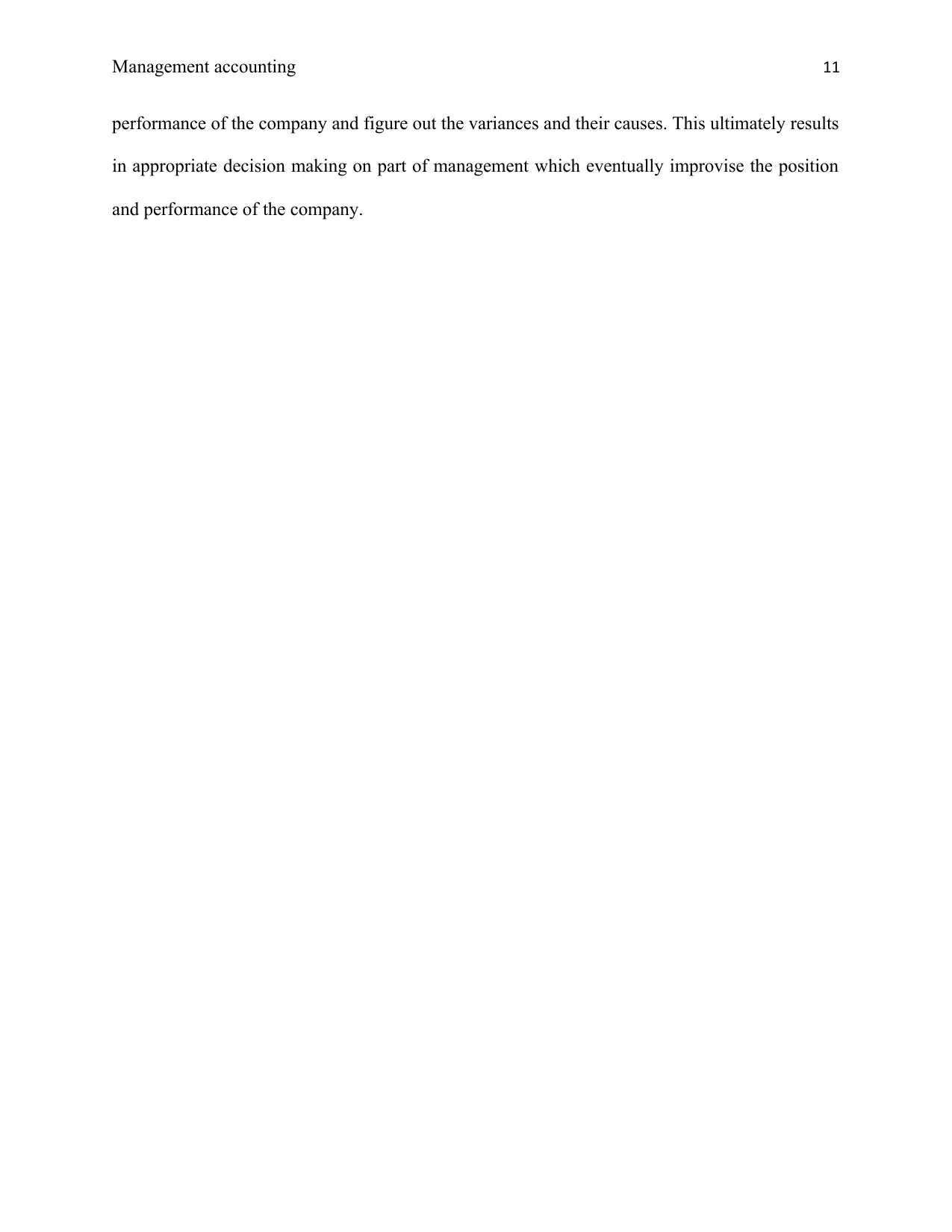
Management accounting 11
performance of the company and figure out the variances and their causes. This ultimately results
in appropriate decision making on part of management which eventually improvise the position
and performance of the company.
performance of the company and figure out the variances and their causes. This ultimately results
in appropriate decision making on part of management which eventually improvise the position
and performance of the company.
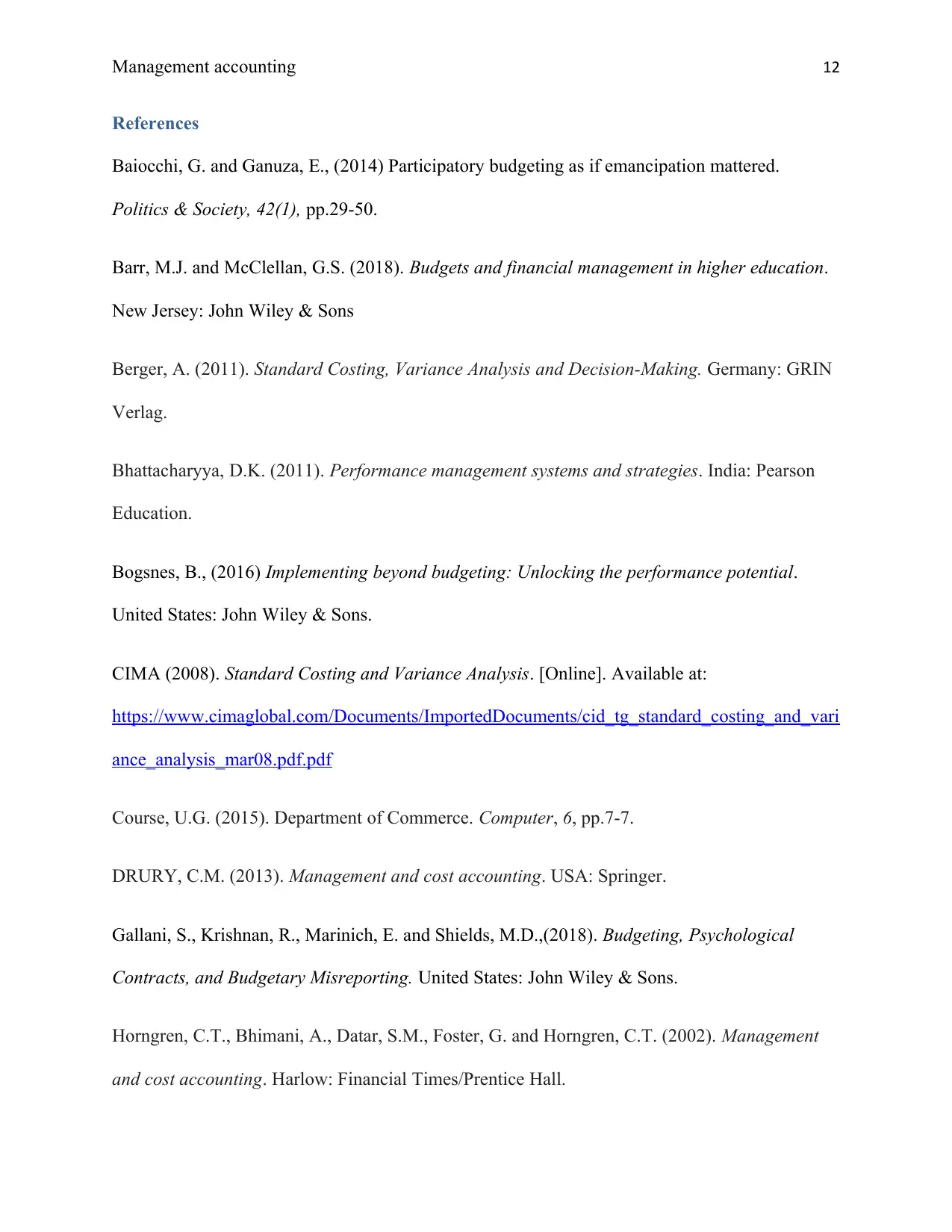
Management accounting 12
References
Baiocchi, G. and Ganuza, E., (2014) Participatory budgeting as if emancipation mattered.
Politics & Society, 42(1), pp.29-50.
Barr, M.J. and McClellan, G.S. (2018). Budgets and financial management in higher education.
New Jersey: John Wiley & Sons
Berger, A. (2011). Standard Costing, Variance Analysis and Decision-Making. Germany: GRIN
Verlag.
Bhattacharyya, D.K. (2011). Performance management systems and strategies. India: Pearson
Education.
Bogsnes, B., (2016) Implementing beyond budgeting: Unlocking the performance potential.
United States: John Wiley & Sons.
CIMA (2008). Standard Costing and Variance Analysis. [Online]. Available at:
https://www.cimaglobal.com/Documents/ImportedDocuments/cid_tg_standard_costing_and_vari
ance_analysis_mar08.pdf.pdf
Course, U.G. (2015). Department of Commerce. Computer, 6, pp.7-7.
DRURY, C.M. (2013). Management and cost accounting. USA: Springer.
Gallani, S., Krishnan, R., Marinich, E. and Shields, M.D.,(2018). Budgeting, Psychological
Contracts, and Budgetary Misreporting. United States: John Wiley & Sons.
Horngren, C.T., Bhimani, A., Datar, S.M., Foster, G. and Horngren, C.T. (2002). Management
and cost accounting. Harlow: Financial Times/Prentice Hall.
References
Baiocchi, G. and Ganuza, E., (2014) Participatory budgeting as if emancipation mattered.
Politics & Society, 42(1), pp.29-50.
Barr, M.J. and McClellan, G.S. (2018). Budgets and financial management in higher education.
New Jersey: John Wiley & Sons
Berger, A. (2011). Standard Costing, Variance Analysis and Decision-Making. Germany: GRIN
Verlag.
Bhattacharyya, D.K. (2011). Performance management systems and strategies. India: Pearson
Education.
Bogsnes, B., (2016) Implementing beyond budgeting: Unlocking the performance potential.
United States: John Wiley & Sons.
CIMA (2008). Standard Costing and Variance Analysis. [Online]. Available at:
https://www.cimaglobal.com/Documents/ImportedDocuments/cid_tg_standard_costing_and_vari
ance_analysis_mar08.pdf.pdf
Course, U.G. (2015). Department of Commerce. Computer, 6, pp.7-7.
DRURY, C.M. (2013). Management and cost accounting. USA: Springer.
Gallani, S., Krishnan, R., Marinich, E. and Shields, M.D.,(2018). Budgeting, Psychological
Contracts, and Budgetary Misreporting. United States: John Wiley & Sons.
Horngren, C.T., Bhimani, A., Datar, S.M., Foster, G. and Horngren, C.T. (2002). Management
and cost accounting. Harlow: Financial Times/Prentice Hall.
⊘ This is a preview!⊘
Do you want full access?
Subscribe today to unlock all pages.

Trusted by 1+ million students worldwide
1 out of 13
Related Documents
Your All-in-One AI-Powered Toolkit for Academic Success.
+13062052269
info@desklib.com
Available 24*7 on WhatsApp / Email
![[object Object]](/_next/static/media/star-bottom.7253800d.svg)
Unlock your academic potential
Copyright © 2020–2025 A2Z Services. All Rights Reserved. Developed and managed by ZUCOL.





